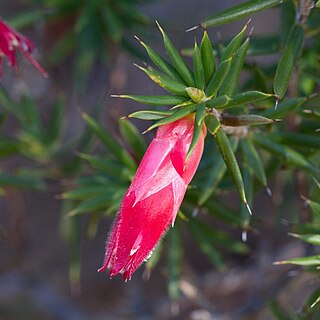
Stenanthera conostephioides, commonly known as flame heath, is a species of small shrub that is endemic to south-eastern continental Australia. It has linear to lance-shaped leaves, red, tubular flowers and green, oval fruit turning dark red.

Styphelia foliosa, commonly known as candle cranberry, is a species of flowering plant in the family Ericaceae and is endemic to the Perth region of Western Australia.
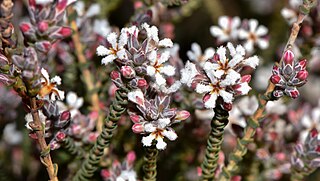
Leucopogon sprengelioides is a species of flowering plant in the family Ericaceae, and is endemic to the south-west of Western Australia. It is an erect shrub with stem-clasping, egg-shaped or lance-shaped leaves and short, dense spikes of white, tube-shaped flowers.

Leucopogon pulchellus, commonly known as beard-heath, is a species of flowering plant in the family Ericaceae, and is endemic to the south west of Western Australia. It is an erect or straggling shrub with erect, linear leaves and short, dense spikes of white, tube-shaped flowers.

Styphelia planifolia is a species of flowering plant in the heath family Ericaceae and is endemic to the south-west of Western Australia. It is a bushy shrub with narrowly oblong or lance-shaped leaves with a small, sharp point on the tip, and white, tube-shaped flowers.

Styphelia crassifolia is a species of flowering plant in the family Ericaceae and is endemic to [the south-west of Western Australia. It is an erect, bushy shrub that typically grows to a height of 60 cm (24 in). Its leaves are oblong, 4–9 mm (0.16–0.35 in) long on a short petiole, with 3 prominent ribs on the lower surface. One or two flowers are borne in leaf axils on a short peduncle with tiny bracts and bracteoles about half the length of the sepals. The sepals are about 1.6 mm (0.063 in) long and the petals are about 3.2 mm (0.13 in) long and joined at the base, the lobes about as long as the tube.
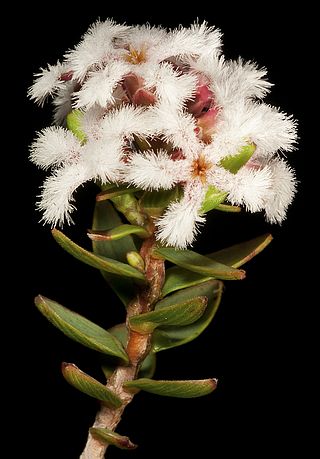
Leucopogon polymorphus is a species of flowering plant in the heath family Ericaceae and is endemic to near-coastal areas of south-western Western Australia. It is a shrub with egg-shaped to lance-shaped or almost linear leaves and short, dense spines of white, tube-shaped flowers.

Styphelia stomarrhena is a species of flowering plant in the family Ericaceae and is endemic to the south-west of Western Australia. It is a low, spreading or compact shrub with narrowly elliptic, sharply-pointed leaves and red, tube-shaped flowers usually arranged singly in leaf axils.
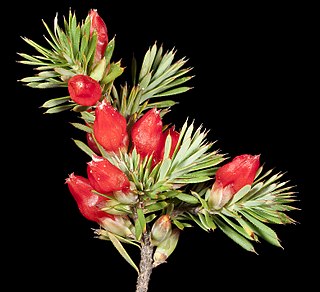
Styphelia tortifolia is a species of flowering plant in the heath family Ericaceae and is endemic to the south-west of Western Australia. It is a shrub with linear or narrowly oblong leaves, and red, tube-shaped flowers with bearded lobes.

Hibbertia striata is a species of flowering plant in the family Dilleniaceae and is endemic to the southwest of Western Australia. It is a spreading shrub with linear leaves and yellow flowers usually with thirty stamens arranged in five bundles around five glabrous carpels.

Brachyloma preissii is a species of flowering plant in the heath family, Ericaceae, and is endemic to Western Australia. It is an erect, dense shrub with linear to oblong leaves and red, or pinkish-red, tube-shaped flowers.
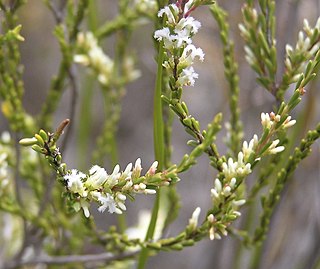
Styphelia corynocarpus is a flowering plant in the family Ericaceae and is endemic to the south-west of Western Australia. It is an erect, open shrub with narrowly egg-shaped to narrowly elliptic leaves, and white flowers arranged in groups of up to five in leaf axils.
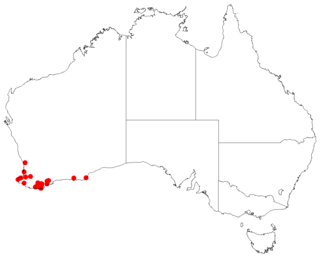
Leucopogon elatior is a species of flowering plant in the heath family Ericaceae and is endemic to the south-west of Western Australia. It is a slender, erect or straggly shrub with broadly egg-shaped leaves, and white, tube-shaped flowers.

Styphelia flavescens is a species of flowering plant in the heath family Ericaceae and is endemic to the south-west of Western Australia. It is a shrub with oblong leaves and white, tube-shaped flowers that are densely bearded on the inside.
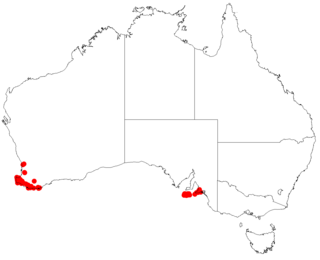
Leucopogon hirsutus is a species of flowering plant in the heath family Ericaceae and is endemic to southern continental Australia. It is a low-lying or straggling shrub with elliptic to oblong leaves and inconspicuous, white, bell-shaped flowers.
Thomasia discolor is a species of flowering plant in the family Malvaceae and is endemic to the south-west of Western Australia. It is a small, compact shrub with hairy new growth, heart-shaped leaves with wavy, lobed edges, and pink flowers in crowded clusters.

Conostephium preissii is a species of flowering plant in the family Ericaceae and is endemic to the southwest of Western Australia. It is an erect shrub with many stems, egg-shaped to oblong leaves and white and purplish to reddish-pink flowers.
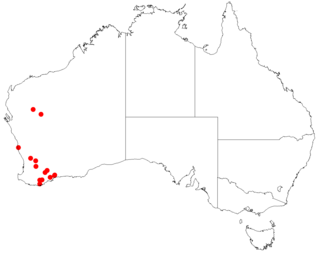
Styphelia retrorsa is a species of flowering plant in the heath family Ericaceae and is endemic to the south-west of Western Australia. It is an erect or straggling shrub that typically grows to a height of 1–2 ft (0.30–0.61 m). Its leaves are egg-shaped with the narrower end towards the base, 4.2–6.3 mm (0.17–0.25 in) long and sessile. The flowers are arranged in pairs or threes in leaf axils on a short peduncle with tiny bracts, and bracteoles less than half as long as the sepals. The sepals are about 2 mm (0.079 in) long, the petals 4.2–5.3 mm (0.17–0.21 in) long and joined at the base, the lobes longer than the petal tube.
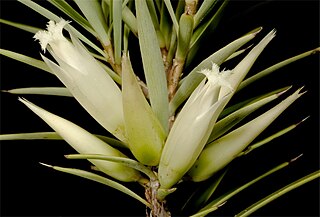
Styphelia macrocalyx, commonly known as Swan berry, is a species of flowering plant in the heath family Ericaceae and is endemic to the south west of Western Australia. It is a shrub with sharply pointed, narrowly lance-shaped leaves and white, tube-shaped flowers with tufts of hairs on the inside.

Styphelia microcalyx, commonly known as native cranberry, is a species of flowering plant in the heath family Ericaceae and is endemic to the south west of Western Australia. It is a much-branched, erect or diffuse shrub with linear or narrowly oblong leaves and red, tube-shaped flowers that are bearded inside.



















